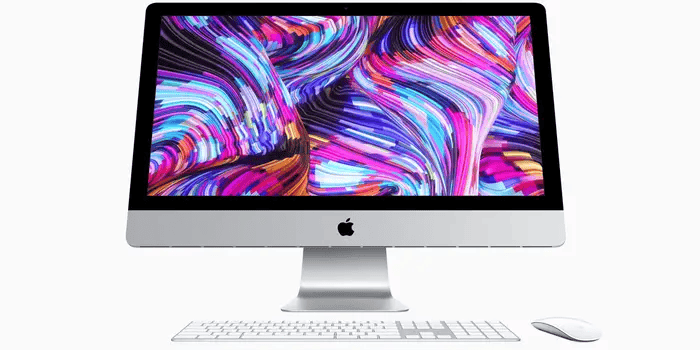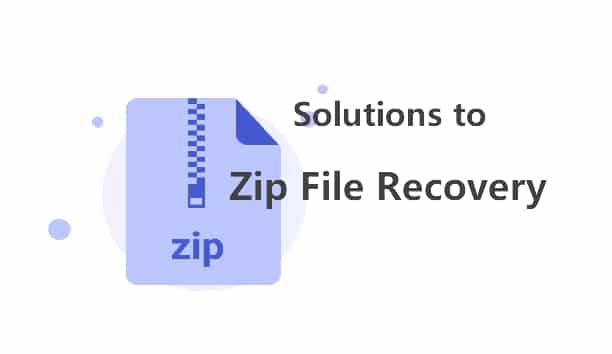Hard drives or partitions turning into RAW format is a common problem many people encounter, which may cause data to be inaccessible or lost. This article will mainly discuss repairing a RAW hard drive and recovering essential data.
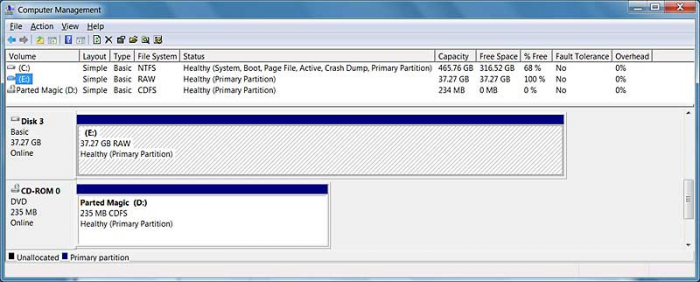
What Does A Raw Drive Mean?
When your disk or partition displays as RAW, it indicates potential issues with the file system of your drive or partition, such as:
● File System Errors: Corruption or damage to the file system structure on the drive can cause it to display as RAW. This could result from abrupt system shutdowns, power failures, or improper ejections of the drive.
● Formatting Issues: Errors during the formatting process or incomplete formatting attempts can leave the drive in a RAW state, making it inaccessible.
● Disk Errors or Malfunctions: Physical issues with the hard drive, such as bad sectors or disk errors, might lead to the drive being detected as RAW.
● Virus or Malware Infections: Infections by malicious software can corrupt the file system or drive structure, causing it to turn RAW.
● Operating System Issues or Updates: Problems arising during operating system updates or software installations might inadvertently affect the drive’s file system, rendering it as RAW.
● Incorrect Disk Operations: Performing incorrect disk operations, such as forceful partitioning, repartitioning, or disk management tasks, can result in a RAW drive.
● File System Incompatibility: Incompatibility issues between the file system of the drive and the operating system could cause the drive to appear as RAW.
Is It Possible to Recover Data from RAW Without Data Loss?
Performing RAW drive recovery without any data loss can be challenging but is often possible with the right tools and methods. However, it’s essential to understand that the success of RAW drive recovery without data loss depends on several factors. Here are some tips to conduct a successful RAW drive recovery without data loss:
| Tip | Detailed Description |
| ⚠️ Stop using the hard drive or partition | Stop using the RAW drive immediately to prevent further damage or overwriting of data. Continued use may exacerbate the problem and decrease the chances of successful recovery. |
| ✅ Choose reliable recovery software | Try to select reputable and reliable data recovery software. These tools can scan the drive, identify recoverable files, and potentially restore them without causing further damage. |
| ⚠️Don’t format or partition the disk. | Do not format or partition the RAW drive to fix the issue. Such actions can overwrite existing data, making recovery more challenging. |
| ✅ Start the recovery process as soon as possible. | Starting the recovery process quickly ensures better chances of saving your lost files before they might get permanently erased or replaced by new data. |
| ✅ Follow recovery guidelines | Follow our instructions carefully to maximize the chances of successful recovery without data loss. |
How to recover data from a RAW drive?
When encountering a hard drive turned into RAW format, you need to take different actions according to the importance of the data. You can consider formatting it directly if the hard drive contains no important data. However, suppose the hard drive contains critical data and has not been backed up. In that case, you are not recommended to format the RAW drive directly and not perform operations such as CMD (chkdsk) because this may further damage the hard drive data.
We have listed two types of methods for you to start the raw drive recovery, free and paid. Let’s dive in!
Method 1: Use A Free Tool
PhotoRec is a free tool that can help recover data from a RAW drive. It may not be as easy to use as some other programs like Disk Drill or ONERECOVERY, but it doesn’t cost anything and can get back lots of files. You can control PhotoRec using a command line, but there’s also a simpler way called QPhotoRec that works well for RAW partition recovery.

Here are the steps to use PhotoRec and QPhotoRec for recovering data from a RAW drive:
Step 1: Download and Extract PhotoRec.
● Get PhotoRec, a free tool for data recovery, and extract the ZIP file.
● Look for qphotorec_win.exe inside the extracted folder if you’re using Windows.
● Double-click on qphotorec_win.exe to launch the application.

Step 2: Select the Partition for Recovery.
● Choose the partition you want to recover data from using PhotoRec.
● Specify the file system the partition used before turning RAW.
● Decide and designate a location to save the recovered files.

Step 3: Start Data Recovery Process.
● Click on the “Search” button within PhotoRec or QPhotoRec to initiate the data recovery process.

QPhotoRec might not show the recovered files before restoring them, unlike some other recovery programs. You won’t be able to select specific files to recover, so ensure you have enough space on another drive to store all the recovered files. Additionally, the recovery process might take some time, and you won’t see what’s recovered until it finishes.
Method 2: Use Professional Data Recovery Software
ONERECOVERY is professional at scanning and recovery, which supports extracting data from a RAW hard drive and saving it to other safe partitions.
Step 1: Download ONERECOVERY and launch it.

Step 2: Choose the hard drive you want to recover and scan.

Step 3: Choose the data you want to recover and press recover, then choose another location to save your file.
👀 Warm tips: Whether it is a removable hard disk, computer disk drive, USB flash drive, memory card, or other storage devices in RAW format, as long as there is no severe hardware failure, it can be recognized by the software typically. You can follow the above operation to extract or recover the lost data.
Which Method Should I Use?
These two methods present different approaches to data recovery from RAW drives. While PhotoRec is a free tool with basic functionalities and no real-time file preview, ONERECOVERY offers professional features, a user-friendly interface, and selective file recovery options, although it is a paid tool. The choice between these methods depends on your technical expertise, preferences, and the level of recovery features required.
| Criteria | PhotoRec | ONERECOVERY |
| Cost | Free | Professional tool requiring purchase, $4.99/Lifetime Plan |
| Ease of Use | Requires some technical knowledge; Command-line or GUI | User-friendly interface |
| Program Features | Basic functionalities; Limited file selection options | Advanced scanning and recovery capabilities |
| File Selection | No real-time preview or selective file recovery | Offers options for selecting specific files to recover |
| Recovery Speed | May take time depending on drive size and data recovery amount | Efficient scanning and recovery process |
| Support and Assistance | Limited support options | No preview of the recovered files |
| Compatibility | Available for various operating systems | Wide range of device compatibility and file systems supported |
| Recovery Result Preview | No preview of recovered files | Offers previews and selection of files before recovery |
How to repair a RAW drive?
Solution 1. Windows Drive Management tool
Step 1. Press “Win + R” > type diskmgmt.msc to open drive Management.
Step 2. Right-click RAW hard drive partition> select “Properties” to go to another screen.
Step 3. Under the “Tools” option, click” Check”> click “Repair Drive” and wait for for the repair to be completed, then restart the computer.

🤗 Solution 1 can be effective under these scenarios:
1. Minor File System Errors: If the RAW drive problem is due to small issues in how files are organized, using the Windows Drive Management tool might help fix it.
2. Non-Critical Data Loss: If the data on the RAW drive isn’t very important or super crucial, trying this method could be a good idea. It might get the drive working again without using any complicated tools.
3. Convenience and Quick Checks: For people who want a simple and quick way to fix the RAW drive without using tricky recovery methods, this tool could be a good start.
Solution 2. Run the CHKDSK command to repair
Step 1.Click the Start menu > type “cmd” in the search bar.
Step 2. Right-click on “Command Prompt” in the search results > select “Run as administrator.”
Step 3. In the window, type “chkdsk<hard drive letter>:f” (if the drive letter of the hard drive is D, then the command is “chkdsk D:f ”) > press the Enter key, wait for the repair to complete and restart the computer.
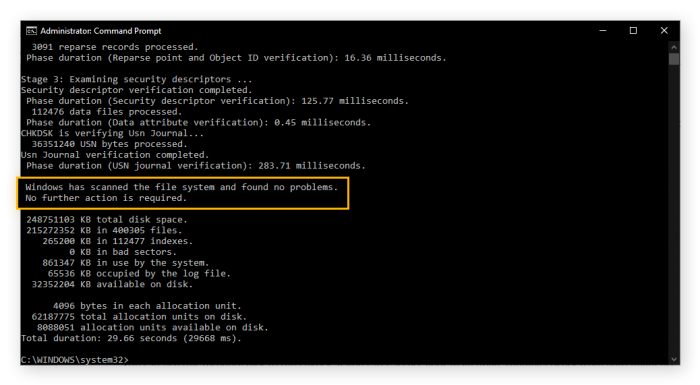
🤗 Solution 2 can be effective under these scenarios:
1. File System Errors: When the RAW drive encounters file system errors, running CHKDSK might help fix these issues.
2. Accessing Drive Issues: If users face difficulties accessing the drive or encounter error messages while trying to open files or folders on the RAW drive, running CHKDSK could potentially resolve these problems.
3. Drive Letter Corruption: In cases where the drive letter becomes corrupted or inaccessible, using CHKDSK with the appropriate drive letter might restore access to the drive.
4. Disk Error Checking: For situations where there are indications of disk errors or warnings prompting the need for disk checking, using CHKDSK can help identify and repair these errors.
Solution 3. Format the RAW hard drive
Step 1. Press win+E to open the File Explorer window> Find the drive in the left column of the interface.
Step 2. Right-click on the hard drive you want to format> Select “Format” in the pop-up menu to open the Format window.
Step 3. In the Format window, select the file system type (NTFS or FAT32 is recommended, the general system default is NTFS) > Select Quick Format in the Format Options > Click the Start button and wait for the formatting to begin.
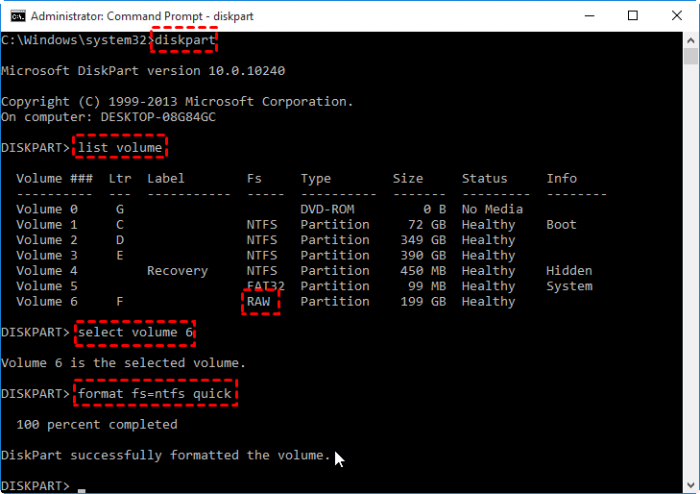
🤗 Solution 3 can be effective under these scenarios:
1. Extreme Data Loss: When the data on the RAW drive isn’t crucial or if users have already backed up all important files, formatting the drive could be an option.
2. Persistent RAW Drive Issues: If other methods fail to fix the RAW drive or if the drive keeps showing RAW status despite attempted repairs, formatting might provide a fresh start.
3. Unusable Drive: In situations where the RAW drive is inaccessible or cannot be read by the system, formatting might be attempted as a last resort to regain usability.
4. Drive Cleanup: For users seeking to erase all data on the drive, starting anew without any existing files or partitions, formatting can serve as a cleanup method.
👀 Warm tips: Please note that the methods mentioned above will affect data integrity on the RAW hard drive, or worse, formatting the RAW drive would erase all the data inside it. So please double-check whether you have backed up or recovered your important data before operation.
How to prevent the hard drive from changing to RAW format?
Hard drives in RAW format could cause us a lot of problems, but we may prevent this by taking the following precautions:
1. Regularly back up the important data. If the hard drive fails, we can still recover the data by backing up the data to avoid permanent data loss.
2. Safely unplug the external hard drive. If you use a removable hard drive, don’t just unplug the cable and make sure you safely remove the external drive. You should safely withdraw the drive from the computer before unplugging it.
3. Avoid overheating. When using the hard drive, please do not use it in an overheated environment. Hard drives have temperature requirements, and overheating can cause damage to the drive.
Conclusion
In conclusion, there are various reasons for the hard drive to turn into RAW format. It is recommended to back up important data in time during regular use. Suppose the hard drive RAW format problem occurs without backing up the data. In that case, you can try to use data recovery software such as ONERECOVERY to extract the hard drive data that cannot be accessed normally.
If the hard drive has a physical failure, resulting in data recovery software can not be recognized successfully, you can try to contact offline professional data recovery agencies to carry out relevant data recovery work.
Further Readings
How To Recover Files From a Corrupted CF Card
7 Effective Ways to Backup Your Data
How to Fix Recycle Bin Is Grayed Out & Recover Data
I’m thrilled to be part of the OneRecovery team as a writer. I’m passionate about simplifying the complex world of data recovery and making it easy for everyone to understand. My focus? Well, I love diving into tutorials on hard drive recovery, crash computer data retrieval, photo repair, and many more. But that’s not all—I’m all about exploring the creative side too, so expect plenty of engaging and imaginative posts on various aspects of data recovery software. Join me on this journey as I share insights, tips, and tricks that make data recovery a breeze!





